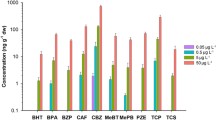Abstract
Subsurface Wastewater Infiltration System (SWIS) is a sewage ecological treatment technology with low investment, energy consumption, and operating cost. SWIS soil contains a large variety of microorganisms. The metabolic process and production of microorganisms are an important basis for qualitatively describing the process of pollutant removal. In order to discover the microbial decontamination pathways in SWIS, the metabolic profiles of soil microorganisms in SWIS were analyzed by UPLC-MS. Partial least squares-discriminant analysis (PLS-DA)and principal component analysis (PCA) pattern recognition methods were used to classify the samples. According to the model's variable importance factor (VIP value), potential biomarkers were screened and biological information contained in the metabolites was also analyzed. The correlation between metabolites and environmental factors was explored by RDA analysis. In total, 230 differential metabolites with VIP value greater than 1.5 were screened out when the influent organic load fluctuated at 250 mg L−1, 400 mg L−1, and 500 mg L−1. After identifying and screening, 35 differential metabolites were identified and used to further analyze the metabolic pathway. It turns out that microbial metabolites in SWIS were mainly glycosides, fatty acids, amino acids, pigments, diterpenoids, and some polymers under medium and high organic loading conditions. At low organic load, the microbial metabolites in SWIS were mainly ketones, alcohols, and esters.
Graphic Abstract








Similar content being viewed by others
References
Liang CL, Li Y, Chai BB et al (2019) Evaluating the effects of intermittent aeration and biochar addition on enhancing removal performance of subsurface wastewater infiltration systems with loess soil. Bioresour Technol Rep 5:12–19
Zheng FP, Huang LL, Pan J et al (2018) Does influent surface organic loading and aeration mode affect nitrogen removal and N2O emission in subsurface wastewater infiltration systems? Ecol Eng 123:168–174
Zhao LF, Zhu W, Tong W (2009) Clogging processes caused by biofilm growth and organic particle accumulation in lab-scale vertical flow constructed wetlands. J Environ Sci 21(6):750–757
Pan J, Yu L, Wang Y (2012) Clogging process caused by organic particle accumulation and biofilm growth in subsurface wastewater infiltration system. J Donghua Univ 29(02):187–192
Kirk JL, Beaudette LA, Hart M et al (2004) Methods of studying soil microbial diversity. J Microbiol Methods 58(2):169–188
Kanazawa S, Itsuki A, Kawagoe M (2005) The numbers and biomass of bacteria and fungi obtained by the dilution plate count method and the direct count method by microscopy (Program for 2005 Annual Meeting of Japanese Society of Soil Science and Plant Nutrition). Jpn J Soil Sci Plant Nutr 76(4):459–470
Aydin S, Shahi A, Gozde Ozbayram E et al (2015) Use of PCR-DGGE based molecular methods to assessment of microbial diversity during anaerobic treatment of antibiotic combinations. Bioresour Technol 192:735–740
Pett RJ (2005) Redox fluctuation structures microbial communities in a wet tropical soil. Appl Environ Microbiol 71(11):6998–7007
Wu Y, Ou YJ, Liao CF et al (2019) High-throughput sequencing analysis of the expression profile of microRNAs and target genes in mechanical force-induced osteoblastic/cementoblastic differentiation of human periodontal ligament cells. Am J Transl Res 11(6):3398–3411
Jones OAH, Sdepanian S, Lofts S et al (2014) Metabolomics analysis of soil communities can be used for pollution assessment. Environ Toxicol Chem 33:61–64
Villas-Bôas SG, Delicado DG, Akesson M et al (2004) Simultaneous analysis of amino and nonamino organic acids as methyl chloroformate derivatives using gas chromatography-mass spectrometry. Anal Biochem 322(1):134–138
Soga T, Imaizumi M (2001) Capillary electrophoresis method for the analysis of inorganic anions, organic acids, amino acids, nucleotides, carbohydrates and other anionic compounds. Electrophoresis 22:3418–3425
Clarissa W, Peet J, Jansen R et al (2016) Can a bmetabolomics-based approach be used as alternative to analyse fatty acid methyl esters from soil microbial communities? Soil Biol Biochem 103:417–428
Ran X, Ying M, Dongjie Z et al (2018) Discrimination of conventional and organic rice using untargeted LC-MS based metabolomics. J Cereal Sci 82:73–81
Patejko M, Jacyna J, Markuszewski MJ (2016) Sample preparation procedures utilized in microbial metabolomics: an overview. J Chromatogr B 1043:150–157
Shao TT, Miki K, Yasumune N et al (2016) Random sample consensus combined with partial least squares regression (RANSAC-PLS) for microbial metabolomics data mining and phenotype improvement. Biosci Bioeng 122:168–175
Hartman WH, Richardson CJ (2013) Differential nutrient limitation of soil microbial biomass and metabolic quotients (qCO2): is there a biological stoichiometry of soil microbes? PLoS ONE 8(3):57–127
He FP, Zhai JC, Zhang L et al (2018) Variations in gut microbiota and fecal metabolic phenotype associated with Fenbendazole and Ivermectin Tablets by 16S rRNA gene sequencing and LC/MS-based metabolomics in Amur tiger. Biochem Bioph Res Co 499:447–453
Zhao H, Liu YJ, Li Z et al (2018) Identification of essential hypertension biomarkers in human urine by nontargeted metabolomics based on UPLC-Q-TOF/MS. Clin Chim Acta 486:192–198
Buyer JS, Vinyard B, Maul J et al (2019) Combined extraction method for metabolomic and PLFA analysis of soil. Appl Soil Ecol 135:129–136
Li YH, Li HB, Xu XY et al (2018) Does carbon-nitrogen ratio affect nitrous oxide emission and spatial distribution in subsurface wastewater infiltration system? Bioresour Technol 18:846–852
Tong LL (2018) Discussion on the application of RDA analysis in water ecology evaluation in CANOCO4.5. Environ Sci 1:45–47 (in Chinese)
Kok EJ, Franssen-van Hal NL, Winnubst LN et al (2006) Assessment of representational difference analysis (RDA) to construct informative cDNA microarrays for gene expression analysis of species with limited transcriptome information, using red and green tomatoes as a model. J Plant Physiol 164(3):337–349
Acknowledgements
This work was supported by the National Natural Science Foundation of China [Grant Numbers 41571455, 51578115].
Author information
Authors and Affiliations
Corresponding author
Additional information
Publisher's Note
Springer Nature remains neutral with regard to jurisdictional claims in published maps and institutional affiliations.
Rights and permissions
About this article
Cite this article
Yang, L., Li, Y., Su, F. et al. Metabolomics Study of Subsurface Wastewater Infiltration System Under Fluctuation of Organic Load. Curr Microbiol 77, 261–272 (2020). https://doi.org/10.1007/s00284-019-01830-5
Received:
Accepted:
Published:
Issue Date:
DOI: https://doi.org/10.1007/s00284-019-01830-5




